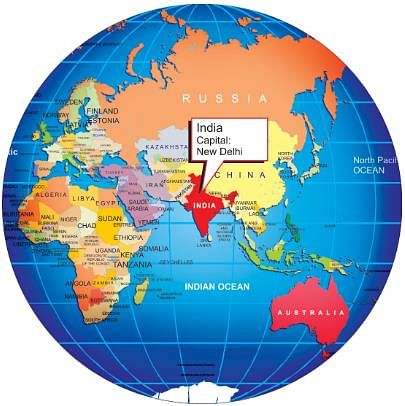Test: India - Location - 1 - UPSC MCQ
10 Questions MCQ Test Geography for UPSC CSE - Test: India - Location - 1
Which of the following statement(s) is/are true?
Statement I: The Tropic of Cancer passes through the southernmost point of India.
Statement II: Indian Standard Time (IST) is based on the 82°30' E longitude.
Which of the following statement(s) is/are correct?
i. The standard meridian of India is 82°30' E longitude.
ii. India’s coastline is the longest in the world.
iii. The southernmost point of India is Kanniyakumari.
iv. India extends from 6°45' N latitude to 37°6' N latitude.
| 1 Crore+ students have signed up on EduRev. Have you? Download the App |
Which of the given below statement(s) is/are correct?
i: India’s latitudinal extent results in diverse climatic conditions across the country.
ii: The distance between two longitudes decreases as one moves towards the poles.
iii: India’s easternmost point experiences sunrise before its westernmost point.
iv: The Indian Standard Time is based on the 68°7' E longitude.
i: India’s latitudinal extent results in diverse climatic conditions across the country.
ii: The distance between two longitudes decreases as one moves towards the poles.
iii: India’s easternmost point experiences sunrise before its westernmost point.
iv: The Indian Standard Time is based on the 68°7' E longitude.
Arrange the following geographical features of India in the correct chronological order based on their formation or significance:
1. Formation of the Himalayas
2. Establishment of the Indian Standard Time
3. Development of the Ganga River system
4. Recognition of India's varied ecosystems
Assertion (A): India shares its borders with several countries in South Asia, including Pakistan, Nepal, and Bhutan.
Reason (R): The geographical location of India allows it to maintain maritime links with its neighboring countries through the Indian Ocean.
Which of the following statement(s) about India's geography is/are correct?
i. India extends approximately 3,214 km from north to south and 2,933 km from east to west.
ii. The southernmost point of India lies at 6°45' N latitude in the Arabian Sea.
iii. The standard meridian of India is 82°30' E, which is ahead of GMT by 5 hours and 30 minutes.
iv. The geographical area of India includes regions in the tropics and sub-tropical zones.
India's longitudinal extent leads to which of the following challenges?
Assertion (A): India's geographical location contributes to significant climatic variations across the country.
Reason (R): The latitudinal extent of India is approximately 30o, resulting in diverse ecosystems and weather patterns.
|
180 videos|475 docs|195 tests
|
|
180 videos|475 docs|195 tests
|



















